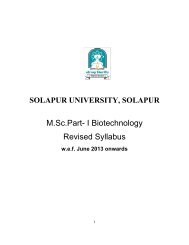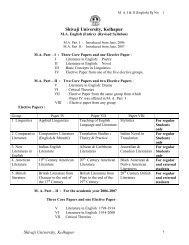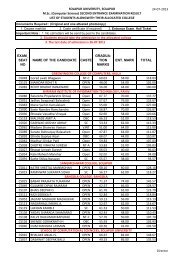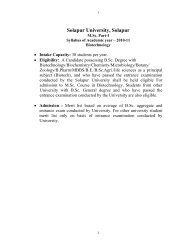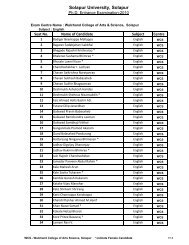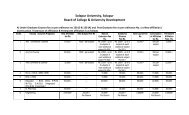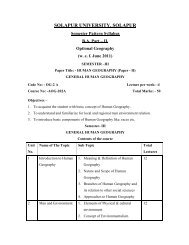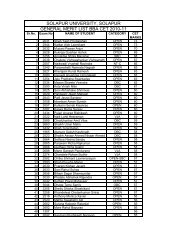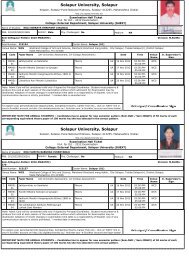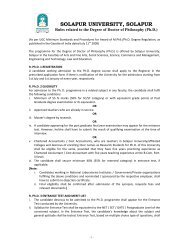Botany - Solapur University
Botany - Solapur University
Botany - Solapur University
- No tags were found...
You also want an ePaper? Increase the reach of your titles
YUMPU automatically turns print PDFs into web optimized ePapers that Google loves.
1SOLAPUR UNIVERSITY, SOLAPURB.Sc. Part – II (<strong>Botany</strong>)Syllabus of semester patternTo be implemented from June, 2011
2SOLAPUR UNIVERSITY, SOLAPURB.Sc. Part – II (<strong>Botany</strong>)-Semester PatternTo be implemented from June-2011There shall be two papers of 50 marks each for each semester. Theory examination willbe held at the end of each semester. The details of courses are as follows.A) Semester-IIIa) Theory paper- V: Development of plants - 50 Marksa) Theory paper- VI: Plant Ecology - 50 MarksB) Semester-IVa) Theory Paper-VII: Plant Physiology- 50 Marksb) Theory paper-VIII: Utilization of plants- 50 MarksC) Total Marks for practical 100 Marksa) Practical – I - 50 Marksb) Practical – II - 50 MarksThe practical course is to be covered in 50 practicals .The practical course should bedivided into practical no.I which will comprise 25 practicals based on Paper No.V & PaperNo.VI where as the practical No.II will comprise 25 practicals based on Paper No.VII &VIII. The practical No I will carry 50 marks & practical II will also carry 50 marks. Thepractical examination will be conducted at the end of semester IV on two successive days.
3SOLAPUR UNIVERSITY, SOLAPURSYLLABUS OF SEMESTER PATTERN B.Sc. Part – II (<strong>Botany</strong>)TO BE IMPLEMENTED FROM JUNE, 2011Semester – III Paper – VDEVELOPMENT OF PLANTS1 The organization of higher plant body: 061.1 The plant organs1.2 Development of the plant body1.3 Internal organization2 Meristems: 062.1 Introduction2.2 Classification2.3 Functions2.4 Theories of structural development –a) The Apical cell theoryb) Histogen Theoryc) Tunica corpus theory3 Tissue systems and their functions: 063.1 Epidermal Tissue System3.2 Secretary Tissue System3.3 Mechanical Tissue System4 Plant tissue and primary structure of plant organs. 074.1 Structure and functions of plant tissues.4.2 Primary Structure of dicot and monocot root, stem, and leaf.5 Secondary body of the plant 085.1 Vascular Cambium5.2 Secondary xylem and secondary phloem
45.3 Periderm, Lenticels and Annual rings.5.4 Basic structure of wood and its types.6 Anomalous secondary growth 076.1 General account6.2 Anomalous secondary growth in Bignonia and Dracaena stemPaper-VIPLANT ECOLOGY1 Introduction 031.1 Holocoenotic nature of environment1.2 Climatic factors1.3 Edaphic factors1.4 Water as a factor1.5 Ecological amplitude2 Population ecology 062.1 Concept2.2 Density2.3 Natality and Mortality2.4 Age distribution of population2.5 Carrying capacity – Brief account2.6 Population Regulation: -By abiotic Factors – nutrients, moisture, food availability.By biotic Factors – competition, predation, density3 Community ecology 043.1 Introduction3.2 The form and structure of communities3.3 Classification3.4 Physiognomy3.5 Community characteristics3.6 Concept of species diversity –α, β and γ
54 Ecosystems 084.1 Introduction4.2 Concept and types4.3 Components and Organization4.4 Biogeochemical cycles – Nitrogen, Oxygen, Carbon, Hydrologic, Sulphur &Phosphorus4.5 Trophic organizations – ecological pyramids, food chains,Different types of food chains.4.6 Trophic organizationsAutotrophy, Heterotrophy, Decomposers.Ecosystem productivity – Primary, Secondary, Gross, NetEnergy flow in ecosystem,5 Ecological adaptations 065.1 Concept5.2 Xeric, Hydric and Mesic adaptations5.3 Adaptations in relation to soil5.4 Ecads, Ecotypes and Ecoclines5.5 Adaptive significance of photosynthetic pathways6 Ecological Succession 056.1 Concept and process6.2 Primary and Secondary succession6.3 Hydrosere and xerosere7 Plant indicators 037.1 Plants as indicators7.2 Role of indicators in environmental monitoring8 Phytogeography 058.1 General principles8.2 Phytogeographical regions of India(As per Chatterjee and Mani)
SEMESTER IVPaper -VIIPLANT PHYSIOLOGY1. Mineral nutrition 051.1 Role of Minerals:Criteria of essentiality of elements,Role of macro (P, K, Ca) and micro (Fe, Mn) elements,1.2 Mineral – nutrient uptake6A) Passive uptake – Diffusion, Cation exchange, Donon equilibriumB) Active uptake – Role of cell membranes, Carrier mediated uptake,Phospholipids hypothesis2 Photosynthesis: 102.1 Introduction and significance2.2 Photosynthetic apparatus2.3 Photosynthetic pigments, accessory pigmentsPhotosystems – reaction center complexesPhotochemical reactionsEmerson enhancement effect.Electron transport pathway in chloroplast membrane.Photophosphorylation2.4 Dark reactionsCalvin cycleC4 cycleCAM3 Transport of organic substances (Phloem Transport) 043.1 Definition of Symplastic transport3.2 Phloem loading and unloading3.3 Mechanism of translocation in phloem (in brief),Mass flow hypothesis,3.4 Source sink relationship:Assimilate partitioning –a. During vegetative phaseb. During reproductive phase
74 Respiration: 064.1 Introduction4.2 Structure of Mitochondrion4.3 Glycolysis4.4 Decarboxylation – Conversion of pyruvate to Acetyl Co-A4.5 TCA cycle4.6 ETS in mitochondria4.7 Oxidative phosphorylation5 Nitrogen metabolism 055.1 Introduction5.2 Nitrogen cycle5.3 Biological N 2 fixation – Definition, types & organisms involved5.4 Mechanism of Biological Nitrogen fixation5.5 Significance of Biological Nitrogen fixation.6 Growth. 106.1 Introduction6.2 Phases of growth6.3 Grand period of Growth6.4 Reproductive growtha. Photoperiodism – physiology of floweringb. Florigen conceptc. Vernalization6.5 Phytohormones.Discovery, chemical nature & practical applications –i) Auxins (IAA) ii) GibberellinsIii) Cytokinins IV) Ethylene V) Abscissic acid
8Paper – VIIIUTILIZATION OF PLANTS1 Domestication of Plants 021.1 Plant introduction1.2 Primary and secondary centers of diversity.2 Legumes 042.1 General account2.2 Botanical name, source and economic importance of chickpea (Bengalgram) red gram and fodder legumes – Lucerne and Sesbania.3 Vegetable oil sources 053.1 General account3.2 Botanical name, source and economic importance of – Groundnut, Soybean.3.3 Brief account of cultural practices of Groundnut & Soybean.4 Plant Fibers 044.1 General account4.2 Botanical name, source, nature and economic importance of – Cotton,Agave and Coir5 Plant perfumes and cosmetics 045.1 A general account5.2 Botanical name, source and economic importance of – Citronella,Jasmine, Rose and Lawsonia.
96 Medicinal plants 10A brief account of plant drugs and their chief constituents used inIndigenous and allopathic systems in –A) Rhizome – Zingiber officinale and Glycirrhiza glabraB) Root – Rauwolfia serpentina, Withania somniferaC) Stem – Tinospora cordifoliaD) Leaf – Aloe vera, Adhatoda zeylanicaE) Floral bud – Syzigium aromaticumF) Fruit – Emblica officinalis and Terminalia chebula7 Natural Products 057.1 Rubber – Plant source and economic importance7.2 General account of plant insecticides7.3 Concise account of dyes and pigments8 Ornamental Plants – Botanical name and ornamental value of following plants 068.1 Seasonals – Aster, Celosia, Chrysanthemum8.2 Perennials – Acalypha, Adenium, Crossandra, Dieffenbackia.8.3 Cacti and succulents – Opuntia and Bryophyllum8.4 Climbers – Bougainvillea, Quisqualis
10<strong>Solapur</strong> <strong>University</strong>, <strong>Solapur</strong>PRACTICALS IN BOTANY AT B.Sc. Part – II(To be implemented from June 2011)Botanical excursions – One teacher along with a batch not more than sixteen students be takenfor Botanical excursions to places of botanical interest, one in each term. If there are femalestudents in a batch of sixteen, one additional lady teacher is permissible for excursion. Eachexcursion will not be more than 3 days during college working days. T.A. and D.A. for teachersand non teaching staff participating in the excursions should be paid as per the rules. The tourreport duly certified by the concerned teacher and the head of the department should be submittedat the time of practical examination.Practical – I and II are to be covered in 25 practicals each. These practicals are to beperformed by the students. Each practical is to be supplemented by permanent slides, preserved /fresh specimens / materials, charts, herbarium sheets, wherever necessary.Every candidate must produce a certificate from Head of the Department in his / hercollege stating that he / she has completed practical course in a satisfactory manner as per thelines laid down by academic council on the recommendations of Board of Studies in <strong>Botany</strong>. Thestudent should record his / her observations and report of each experiment should be written inthe Journal.The Journal is to be signed periodically by teacher in charge and certified by Head of theDepartment at the end of the year. Candidates have to produce their certified journal and tourreports at the time of practical examination. A candidate will not be allowed to appear for thepractical examination without a certified journal, otherwise a candidate must produce a separatecertificate of his / her regular attendance for practical course and completion of the same signedby the concerned teacher and Head of the Department.Distribution of Marks:Practical I - 50 MarksPractical II - 50 Marks
11Practical – ISr. No. Particulars Marks1. Plant Anatomy 202. Plant Ecology 203. Journal 054. Tour report 0550 MarksPractical – II1. Plant Physiology 202. Economic <strong>Botany</strong> 203. Journal 054. Horticultural Term Paper 0550 MarksEach practical examination (Practical I and II) should be of maximum. 5 hours durationand shall test a candidate in respect of following –i. Identification and preparation of temporary and permanent slides.ii. Practical study of external and internal structures of different plants as per the syllabus.iii. Understanding of principles of the experiments.iv. Identification and setting of ecological experiments.v. Identification and setting of Physiological experiments.vi. Recording of observations and conclusions.vii. Identification and understanding of the practicals conducted with respect todevelopment of plants and their utilization.viii. Spotting of the specimens as per the syllabus.ix. Submission of the tour report and Horticultural term paper.
12B.Sc. Part – II (<strong>Botany</strong>)Practicals (Laboratory Exercise)Practical No. I (Based on Paper – V &VI )1 and 2 Study of organization in a following plant.Using w.m. of shoot tips of Hydrilla / V. S. of Coleus orBryophyllum and w.m. of root tips of Pistia or V.S. of root tips ofOnion / Maize / Aerial roots of Ficus / Tinospora.3, 4 Anatomy of root, stem and leaf using hand sectionsor permanent slides (Sunflower & Maize)5 6 Anomalous secondary growth in Bignonia and Dracaena stem by usingpermanent double staining technique.7 Secondary growth in dicot stem and root.8 Maceration technique.9 ,10 Study of Epidermal, Mechanical and Secretory tissue systems.11 Study of anatomy of porous (ring porous & diffused porous) and non porous wood.Understanding of wood anatomy by using T.S. / TLS / RLS in Eucalyptus andPinus stem..12, 13 Field study of Hydrophytes, Mesophytes, Xerophytes, Parasites and Trees withvaried canopy architecture.Field diary to be prepaired.14 To study the working and use of meteorological instruments.15 & 16 To study texture, pH and water holding capacity of soil (Two soils)17 & 18 Determination of density & frequency of different plant species by quadrat method.19 To prepare a report on any ecosystem from near by locality.20, 21 & 22 To study maps of India with respect to major climatic zones,forest types and biogeographical regions.23 Ecological adaptations in morphology and anatomy of hydrophytes –1) Submerged, 2) Floating, 3) Amphibious (One plant from each group)24 Ecological adaptation of xerophytes (Nerium & Aloe).25 Ecological adaptations of Epiphyte (Aerides) and parasite (Cuscuta)
13Practical No. II (Based on Paper VII & VIII)1 To study permeability of plasma membrane using different concentrationsof organic solvent.2 To study structure of stomata and to determine the stomatal index.3 Detection of essentiality of mineral elements by Hydroponics / Sand culture andwith the help of chart4 To demonstrate the presence of Calcium,Phospate, Potassium, Iron and Nitrogenin the plant tissue.5 To extract and separate photosynthetic pigments by ascendingpaper chromatography.6 To study the effect of CO 2 concentration on the rate of photosynthesis7 To study C3 and C4 plants by Kranz anatomy.8 Estimation of TAN.9 To study respiration in germinating seeds.10 Analysis of vegetative growth.11 &12 To study the effect of growth regulators (IAA,GA,CCC &ABA) onseed germination and seedlings growth.13 Study of maps showing the centres of primary diversity of importanteconomic plants that originated in India14 Study of map showing the plants of economic importance introduced in India fromother Countries.15 Study of Vegetative, Floral morphology and pod in Chickpea, Red gramand fodder legumes as per theory.16 Study of structure of oil storing tissues in sectioned seeds of Mustard, Groundnut,Soybean and Coconut endosperm using micro chemical tests.17,18 Study of vegetative, Floral and Fruit morphology of Cotton.Microscopic structure Cotton fiber, Preparation of absorbent Cotton by alkali treatment,Staining of Cotton with and without mordating.19 Study of plants (live or herbarium) used as resource of drugs as pertheory.20 Study of plant insecticides sources –Azadirachta indica, Artemisiaannua, Chrysanthemum cinerarifolium and Nicotiana tabaccum.
1422 Sources of dyes – Curcuma longa, Bixa orellana, Crocus sativus,Butea monosperma, Indigofera (Indigo) Lawsonia inermis22 Study of aromatic plants. (As per theory)23 Extraction of aromatic oil by distillation method.24 Study of ornamental plants ,as per theory, seasons of flowering plantsAnd botanical names with description in brief.25 Horticultural term Paper-ornamental plants – Seasonals ,perennials ,climbers, cacti, succulents, bonsai, indoor plants, cut flowers etc.
15<strong>Solapur</strong> <strong>University</strong>, <strong>Solapur</strong>B.Sc. Part – II Practical Examination, March / April 2012BOTANY PRACTICAL – ICentre: Total Marks: 50Date:Time: 11.00 am onwardsN.B. : 1. Draw near labelled sketches whenever necessary.2. Do not write about theoretical points, unless asked specifically.3. Record your observations carefully and neatly wherever asked.Q. 1 Make a double stained permanent micro preparation of a T.S. ofSpecimen A. 09Q. 2 Macerate the given material B and prepare the slide from it. Showthe slide to the examiner. 05Q. 3 a) Prepare the list quadrat of the marked area and find out the percentageFrequency / Density of different species there in. 09b) Set up the ecological experiment assigned to you & show it to the examineror Describe the ecological adaptation in the given specimen. 05Q. 4 Identification(From 2010 to 2011 and onwards)a) Identify and describe (Anatomy) 02b) Identify and describe (Anatomy) 02c) Identify and describe (Anatomy) 02d) Identify and comment – (Ecology) 02e) Identify and comment – (Ecology) 02f) Identify and comment – (Ecology) 02Q. 5 a) Journal 05b) Submission of Excursion report. 05TOTAL----50
16<strong>Solapur</strong> <strong>University</strong>, <strong>Solapur</strong>B.Sc. Part – II Practical Examination, March / April 2012BOTANY PRACTICAL – IICentre: Total Marks: 50Date:Time: 11.00 am onwardsN.B. : 1. Draw near labeled sketches wherever necessary.2. Do not write about theoretical points, unless asked specifically.3. Record your observations carefully and neatly wherever asked.Q. 1 Set up the physiological experiment assigned to you and record yourobservation, submit the report to the examiner. 09Q. 2 Arrange the physiological experiment given to you and show it to 05the examiner.Q. 3 a) Identify, give the botanical name and uses of specimen A&B.08b) Identify, give the botanical name ,plant part/s used and uses ofSpecimen C 06Q. 4 Identifications:a) Identify and comment – (Physiology) 02b) Identify and comment – (Physiology) 02c) Identify and comment – (Physiology) 02d) Identify and comment (Plant utilization) 02e) Identify and comment (Plant utilization) 02f) Identify and comment (Plant utilization) 02Q. 5 a) Horticultural Term Paper. 05b) Journal. 05TOTAL------ 50
Suggested ReadingsDevelopment of Plant / Anatomy.1. P.C. Vasista. Plant Anatomy. Pradip Publications, Opposite Sitla mandir,Jalandhar- 144008.2. B.P.Pandey Plant Anatomy. S.Chand & Company,LTD. Ram Nagar, NewDelhi.110055.3. A.C.Datta. <strong>Botany</strong> For Deree students. Press-Delhi, Bombay, Madrass.S174. Carlquist, S. 1998. Comparative Wood Anatomy: Systematic, Ecological and EvolutionaryAspects of dicotyledonous Wood. Springer – Verlag, Berlin.5. Culter, E.G. 1969. Part I. Cells and Tissues. Edward Arnold, London.6. Culter, E.G. 1971. Plant Anatomy: Experiment and Interpretation. Part II Organs. EdwardArnold, London.7. Esau, K. 1977. Anatomy of Seed Plants, 2 nd edition, John Wifey and Sons, New York.8. Fahn, A. 1974. Plant Anatomy, 2 nd edition. Pergamon Press, Oxford.9. Lyndon, R.F. 1990. Plant Development: The Cellular Basis. Unwin Hyman, London.10. Mauseth, J.D. 1988. Plant Anatomy. The Bonjamin/Cummings Publishing Company Inc.,Metro Park, California, USA.11. Nair, M.N.B. 1998. Wood Anatomy and Major Uses of Wood. Faculty of Forestry,Universiti Putra Malaysia, 43400 Serdang, Selangor D.E., Malaysia.12. Rahvan, V. 2000. Developmental Biology of Flowering Plants. Springer-verlag, New York.13. Raven, P.H., Evert, R.F. and Eichhorn, S.E. 1999. Biology of Plants. 5 th edition. W.H.,Freeman and Co., Worth Publishers, New York.14. Steeves, T.A. and Sussex, I.M. 1989. Patterns in Plant Development, 2 nd edition.Cambridge <strong>University</strong>, Press, Cambridge.15. Thomas, P. 2000. Trees: Their Natural History. Cambridge <strong>University</strong> Press, CambridgePlant Ecology1. Odum, E.P. Ecology. Oxford & F.B.h.Publishing Co.pvt.LTD-New Delhi..2. Barbour, M.G., Burk, J.H. and Pitts, W.D. 1987. Terrestrial Plant Ecology. Benjamin /Cummings Publication Co., California.3. Kormondy, E.J. 1996. Concepts of Ecology, Prentice-Hall of India Pvt. Ltd., New Delhi.4. Hill, M.K. 1997. Understanding Environmental Pollution. Cambridge <strong>University</strong> Press.
185. Mackenzie, A. et al. 1999. Instant Notes in Ecology. Viva Books Pvt. Ltd., New Delhi.6. Ashok Bendre / Ashok Kumar Economic <strong>Botany</strong> Rastogi Publications Shivaji Road,Meerut – 250002 India.7. Prof. M.A. Khan – Environment, Biodiversity and Couservation S-B Nangia, A.P.H.Publishing Corporation, 5, Ansari Road, Daryaganj New Delhi – 110002.8. B.P. Pandey – Modern Practical <strong>Botany</strong> Vol – I / II Chand & Company Ltd. RamnagarNew Delhi – 110055.9. B.P. Pandey – Economic <strong>Botany</strong> Vol – I / II Chand & Company Ltd. Ramnagar NewDelhi – 110055.10. Pavas Divan – Environ Protection – Deep & Deep Publications D-I 124, Rajouri Garden,New Delhi – 110027.11. P.S. Verma / V.K. Agrawal – Concept of Ecology, S. Chand & Lonpan Ltd. Ramnagar,New Delhi – 110055.12. Eug Warming – Ecology of Plants, Ambey Publications Delhi (India)13. Evgene P Odum – Ecology Oxford & IBH Publishing Co. Pvt. Ltd. Culcutta, New Delhi.14. Ishwar Prakash. Desert Ecology. Scientific Publications, Ratandas Road,Jodhpur.-342001-India.15. T.W. Woodhead. Plant Ecology. Sonali Publications.New Delhi.110002.16. Eug. Warming. Ecology Of Plant. Ambey Publications Delhi.17. Jonathan Silvertown. Introduction To Population Plant Ecology. Longman Singapure.Publisher, LTD.18. R.S. Shukla & P.S. Chandel. Plant Ecology. S.Chand & Company LTD. Ram Nagar, NewDelhi.110055.Plant Physiology1. Hopkins, W. G. 1995. Introduction to Plant Physiology. John Wiley & Sons, Inc., NewYork, USA.2. Moore, T. C. 1989. Biochemistry and Physiology of Plant Hormones (2 nd edition).Springer – Verlag, New York, USA.3. Salisburry, F.B. and Ross, C.W. 1992. Plant Physiology (4 th edition). WadsworthPublishing Co., California, USA.
194. Taiz, L. and Zeiger, E. 1998. Plant Physiology (2 nd edition) Sinauer Associates, Inc.,Publishers, Massachusetts, USA.5. R.C. Grewal – Plant Physiology Campus Brokes International 483/24, Prahiad streetAnsari Road, Darya ganj, New Delhi – 110002.6. V.K. Jain – Fundamentals of Plant Physiology, S. Chand & Company Ltd. Ramnagar,New Delhi – 110055.7. Salisbury Ross – Plant Physiology CBS, Publishers & Distributions 485/ Jain Bhawan,Bhole Nath Nagar, Shahdara, New Delhi – 110032.8. Devlin & Witham – Plant Physiology CBS Publishers & Distributors 485, Jain Bhavan,Bhole Nath Nagar, Shahdara, New Delhi – 110032.9. G. Ray Noggle / G. Fritz Introductory Plant Physiology Prentice Hall of India Ltd. NewDelhi – 110001.10. V.Verma. Text Book Of Plant Physiology. Emkay Publications.,B-19,East Krishna Nagar,Delhi-1100051.11. V.I. Paladin. Plant Physiology. Arihant Publishers. Jaypur, (India)12. Dr. S. Sundara rajan. Physiology Of Transport In Plants. Anmol Publications, Pvt. LTD.New Delhi.110002.13. D.O.hall & K.K. Rao. Photosyntheis. Edward Arnold, East Street, Baltimore, Mary-land-21202,U.S.A.Plant Utilization.1. R.C. Grewal – Medicinal plants, Campus Books International 4831/24, Prahiad street,Ansari Road, Darya Ganj, New Delhi – 110002. Fax : 91-011-3257835.2. F.O. Bower – Plants and Man Ariana Publishing House, New Delhi – 110012.3. Fuller, K.W. and Galon, J.r. 1985. Plant Products and New Technology. Calrendon Press,Oxford, New York.4. Kocchar, S.L. 1998. Economic <strong>Botany</strong> in Tropics, 2 nd edition. Macmillan India Ltd., NewDelhi.5. Sambamurthy, A.V.S.S. and Subramanyam, N.S. 1989. A Textbook of Economic <strong>Botany</strong>,Wiley Eastern Ltd., New Delhi.6. Sharma, O.P. 1996. Hill’s Economic <strong>Botany</strong>. Tata McGraw Hill Publishing CompanyLtd., New Delhi.
207. Simpson, B.B. and conner-Ogorzaly, M. 1986. Economic <strong>Botany</strong> – Plants in Our World.McGraw Hill, New York.8. Tippo, O. and Stern, W.L. 1977. Humanistic <strong>Botany</strong>. W.W. Norton, New York.9. B.P.Pandey Economic <strong>Botany</strong>. S.Chand & Company pvt. LTD. Ram Nagar New Delhi.110055.10. Bentley & Trimen. Medicinal Plants. Asiatic Publishing house, 181 D.J. Extension, LaxmiNagar. Delhi. 110092.11. Robert Brentley & Henry Trimen. Medicinal Plants. Londan J & AChureldill.NewRulington Street.12. He nery Kraemer Applied Economic <strong>Botany</strong> Ambey Publications, New Delhi.13. A Textbook of economic <strong>Botany</strong> (EDN 1989)By SAMBA MURTY & N S Subramanyam. Publ.Wiley Estern LTD.New Delhi .14. A Text book of Medicinal plantsBy.Prajkta, Purohit, Sharma, Kumar (2007)Publ. by Agro bios (India) Agrohouse Jodhpur 342002.
SOLAPUR UNIVERSITY ,SOLAPURNature of Question Paper For Semester Pattern(For Paper V,VI,VII &VIII)Faculty Of Science( w .e .f. June 2011)Time: 2 hrs. Total Marks: 5021Q.No.1) Multiple choice questions. (10)1) ---------------------------------------------a) b) c) d)2)3)4)5)6)7)8)9)10)Q.No.2) Answer any Five of the following (10)i)ii)iii)iv)v)vi)Q.No.3) A) Answer any Two of the following (06)i)ii)iii)B) Write the Answer/Solve/Problem/Note (04)Q.No.4) Answer any Two of the following (10)i)ii)iii)Q.No.5) Answer any Two of the following (10)i)ii)iii)



